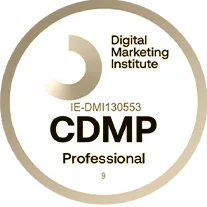
Emotive Marketing Isn't Just 'Sad' Stories: The Benefits of Full-Spectrum Emotional Marketing
When we’re creating a design for a brand, or developing a color palette, each brand is unique. Each collection of colors tells its own story without words. This is much like the expansive array of emotions that humans experience, with each color/emotion playing its unique role in influencing perceptions, decisions and actions.
It is this rich emotional palette that forms the core of Emotive Marketing.
There is a common misconception that persists in the marketing world that only stories evoking melancholy or sorrowful responses are most effective at driving consumer engagement. This is a narrow perspective; different emotional triggers can significantly influence consumer behavior and decision-making processes: passion can fuel product loyalty, while unexpected surprises can generate memorable brand encounters. People like to think they’re always making choices with logic and research and data — but that’s a very small part of the decision-making process when compared to emotions. People make decisions, almost always, based on emotional reactions.
Even negative emotions like anger can be harnessed for positive change when channeled correctly in awareness campaigns or cause-related marketing strategies. As a result, it’s important to understand and leverage this full-spectrum approach to emotion-based marketing for more effective and impactful results.
The Power of Joy in Emotive Marketing
Integrating joy into emotional marketing strategies can significantly amplify consumer engagement, cultivating a sense of connection and positive association with the brand. This approach, often referred to as “Joy Marketing,” leverages positive emotions to foster a deeper relationship between consumers and brands.
Eliciting feelings of joy in consumers not only enhances their immediate perception of the brand but also encourages long-term loyalty. Joy is one emotion that universally resonates across cultures and demographics, making it an effective tool for reaching diverse audiences.
A study conducted by Nielsen found that ads evoking strong positive emotions were three times more likely to be shared than those without any emotional content. Moreover, joyful branding contributes towards creating memorable experiences for consumers, which is been linked with increased customer retention rates. These benefits are not just limited to B2C sectors; even in B2B settings businesses can successfully harness the power of joy to differentiate themselves from competitors and form lasting relationships with clients.
The efficacy of joyful branding lies primarily in its ability to create a compelling narrative around the brand — one that emphasizes positivity, enlightenment, and shared happiness. By connecting with customers on an emotive level, companies not only enhance their overall image but also increase their chances of driving consumer action. The tangible business outcomes such as elevated sales numbers or improved customer acquisition metrics underline the potential impact this type of emotional marketing can generate when executed effectively.
Creating Excitement: Igniting Customer Passion
Cultivating a sense of exhilaration in consumers can significantly ignite their passion, thus fostering a deeper connection and anticipation with the brand. Red Bull is an example that comes to mind instantly when discussing this topic (less so the “Red Bull Gives You Wings” animations, and more so the high-adrenaline sponsored stunts).
This form of emotional marketing, sometimes referred to as “Passion Conversion,” leverages high-energy emotions like excitement and anticipation to generate fervor for products or services. An increase in consumer enthusiasm can lead to higher customer engagement rates, thus positively impacting sales figures and overall business performance.
By generating genuine excitement around a brand or product, businesses not only attract potential customers but also create loyal advocates who will willingly share their positive experiences with others. Incorporating this type of emotive marketing strategy requires an understanding of the target audience’s passions and interests. For instance, sports brands might leverage the thrill of competition and achievement, while technology companies may capitalize on the anticipation created by innovative breakthroughs or exclusive product releases.
The goal is to spark an emotional reaction that aligns with these interests, encouraging consumers to associate these positive feelings with the marketed brand or product. Data-driven approaches such as sentiment analysis and customer surveys can help marketers gauge current levels of consumer passion and identify opportunities for enhancing it.
Engaging consumers through methods designed to stoke their enthusiasm offers multiple benefits beyond increased sales figures — it also aids in building stronger brand-customer relationships. When brands successfully tap into consumer’s passions they foster a sense of community among users; individuals feel understood and valued by the company, which results in elevated trust levels and long-term loyalty.
A well-orchestrated “Passion Conversion” campaign can transform casual browsers into dedicated advocates—those who not only enjoy using the product or service but actively promote it within their network due to their emotional investment in it — an outcome beneficial for both parties involved.
Surprise and Delight: Captivating Audiences with Unexpected Moments
Surprising consumers with unexpected moments can have a remarkable effect on their engagement levels, as evidenced by a recent study which found that 94% of customers felt more positive about a company after experiencing a “surprise and delight” tactic. This method of unforeseen engagement goes beyond the typical marketing strategies. It is no longer enough to simply offer quality products or services — brands need to create unique, memorable experiences for their audience. These unexpected elements in marketing not only captivate consumers, but they also foster loyalty and facilitate long-term relationships between the customer and the brand.
Unexpected Marketing Tactic | Impact on Consumer Behavior |
Personalized Offers | Increased Purchase Intention |
Exclusive Perks | Enhanced Brand Loyalty |
Unique Experiences | Boosted Engagement Levels |
These strategies can significantly increase customer satisfaction and drive sales. But more than that, they create an emotional connection with consumers — transforming them from mere buyers into passionate brand advocates.
Surprise-based marketing is much more than just an effective tool in promoting business growth; it plays an integral role in fostering meaningful connections with customers while establishing strong brand identity. Brands should therefore continue to explore creative ways to incorporate surprise and delight tactics into their respective marketing strategies — not only can this lead to increased profit margins but it will also contribute towards building sustainable relationships with clients based on trust and mutual respect.
Why Tear-Jerking Moments are Some of the Most Effective Marketing Devices
Utilizing tear-jerking moments in advertising campaigns has proven to be a highly effective strategy for resonating deeply with consumers, influencing their purchasing decisions, and establishing lasting brand connections. Emotional marketing strategies, particularly those that evoke sadness or strong empathy engagement, have the potential to trigger profound emotional responses in viewers.
This approach is grounded in the psychological principle that humans are intrinsically motivated to connect with others on an emotional level. Consequently, advertisements that present emotionally-charged narratives can stimulate feelings of sympathy and compassion among viewers, thereby fostering an emotional bond between the consumer and the brand.
Leveraging tear-jerking moments within marketing campaigns acts as a catalyst for empathy engagement. It enables brands not only to capture attention but also cultivate deeper relationships with their audience through shared emotions. Audiences are more likely to remember advertisements infused with emotion compared to those that rely solely on information or logical appeals.
This heightened recall can be attributed to the fact that emotional experiences — including those elicited by powerful ads — tend to be stored more effectively within our long-term memory.
Moreover, cultivating empathy through tear-jerking stories carries significant implications for consumer behavior. Consumers who feel understood and emotionally connected with a brand often display higher levels of trust, loyalty, and advocacy towards it; these factors collectively contribute towards improving customer retention rates and boosting overall sales performance. Thus, deploying emotive narratives not only differentiates companies from competitors but also fosters sustainable growth by nurturing enduring relationships based on shared values and mutual understanding.
Something we’ve seen personally in the non-profit space, is that people tend to give hundreds of percent more when they’re moved through a message designed to evoke empathy. We’ve been told by clients that they couldn’t believe the reactions (and donations) they got from viewing empathy-evoking videos at a fundraising event.
Tapping into Anger: Channeling Emotion for Social Change
Channeling anger as an emotional tool can be a potent catalyst for change, offering a unique approach to raising awareness and inciting action on critical issues.
But anger doesn’t have to be all “social justice” or politics. Some ads use anger very effectively without relying on the low-hanging fruit of social rage. Think about the classic Sarah McLachlan ads for the SPCA. On the surface, it might seem like “sadness” is the main emotion we’re supposed to feel. But the real underlying emotion that the ads evoke is anger — we’re angry that some dogs are treated so poorly.
These specific ads from the SPCA are very effective, and very memorable. Unfortunately, sometimes ads that use anger and fear to reach an audience are memorable for the wrong reasons.
It’s important to remember that inciting anger simply for the purpose of exposure or engagement is not wise, nor effective. Unfortunately, some marketers — especially in the trigger-happy social media world — use anger and rage merely as an engagement tool to pad vanity metrics, which dissolves trust and acceptance of the ethical marketing that most advertisers participate in.
For marketers aiming at promoting change through their campaigns, understanding and leveraging the transformative power of collective anger is a valuable tool for generating lasting impact. Anger is one of the easiest emotions to evoke in much of the general population, but it’s also the most difficult to harness properly and avoid negative consequences.
The Holistic Approach: Harnessing the Full Emoptional Spectrum in Marketing
In the realm of strategic communication, a comprehensive approach that harnesses a full range of human sentiments can yield profound effects on audience engagement and action.
A holistic approach uses emotion mapping as an integral part of marketing strategies to understand and tap into the entire emotional spectrum of potential audiences. This method goes beyond traditional demographic factors, delving into psychographics to establish deeper connections with consumers.
It engages people’s inherent desire to serve others by appealing to emotions that promote empathy, compassion, and social responsibility. Though there is a vast spectrum of specific emotions marketers can (and do) use, these four encompass most of that emotional spectrum:
1. Joy: Positive emotions such as joy or happiness can create a sense of connection between the brand and its customers. Joyful marketing campaigns often involve heartwarming stories or experiences that inspire positive feelings in customers.
2. Trust: Building trust is crucial for long-term customer relationships. Trust-based marketing strategies might include transparent business practices or customer testimonials.
3. Fear: Fear-based tactics should be used sparingly but can be effective when trying to prompt immediate action – such as urging people to buy a product before it sells out.
4. Surprise: Unexpected elements in marketing campaigns can heighten interest and intrigue, motivating potential customers to learn more about the brand.
Harnessing these diverse emotional responses enables marketers not only to attract attention but also foster deeper connections with audiences through shared values and experiences. Emotion mapping plays an indispensable role in this process by providing insights into how different stimuli trigger various emotional responses within individuals, offering invaluable data for crafting resonant messages and narratives that speak directly to their hearts rather than just their minds.
Thus, embracing a holistic approach that utilizes the full emotional spectrum allows organizations to engage audiences on multiple levels, fostering stronger ties while simultaneously promoting products or services in ways that resonate deeply with those they aim to serve – ultimately leading towards more meaningful interactions and increased customer loyalty over time without necessarily having explicit conclusions in sight at every turn along this journey of strategic communication planning.
Conclusion
Through comprehensive analysis, we know that marketing strategies harnessing the full emotional spectrum have proven exceptionally effective. This research underscores the potency of emotive marketing not just limited to tear-jerking moments but also incorporating other sentiments.
As marketers continue to explore this multifaceted approach, more impactful and dynamic connections with consumers can be expected.This paves the way for innovative marketing strategies that will shape future consumer-brand relationships.

